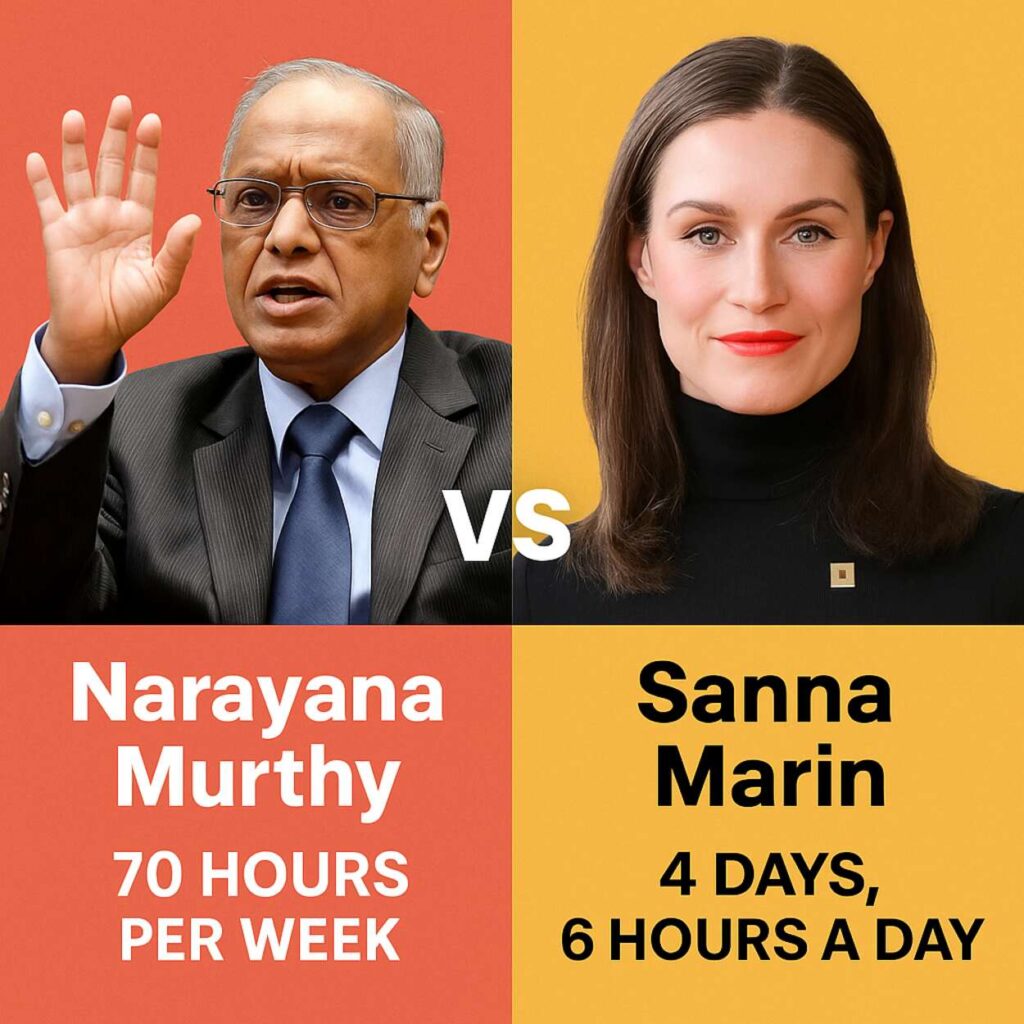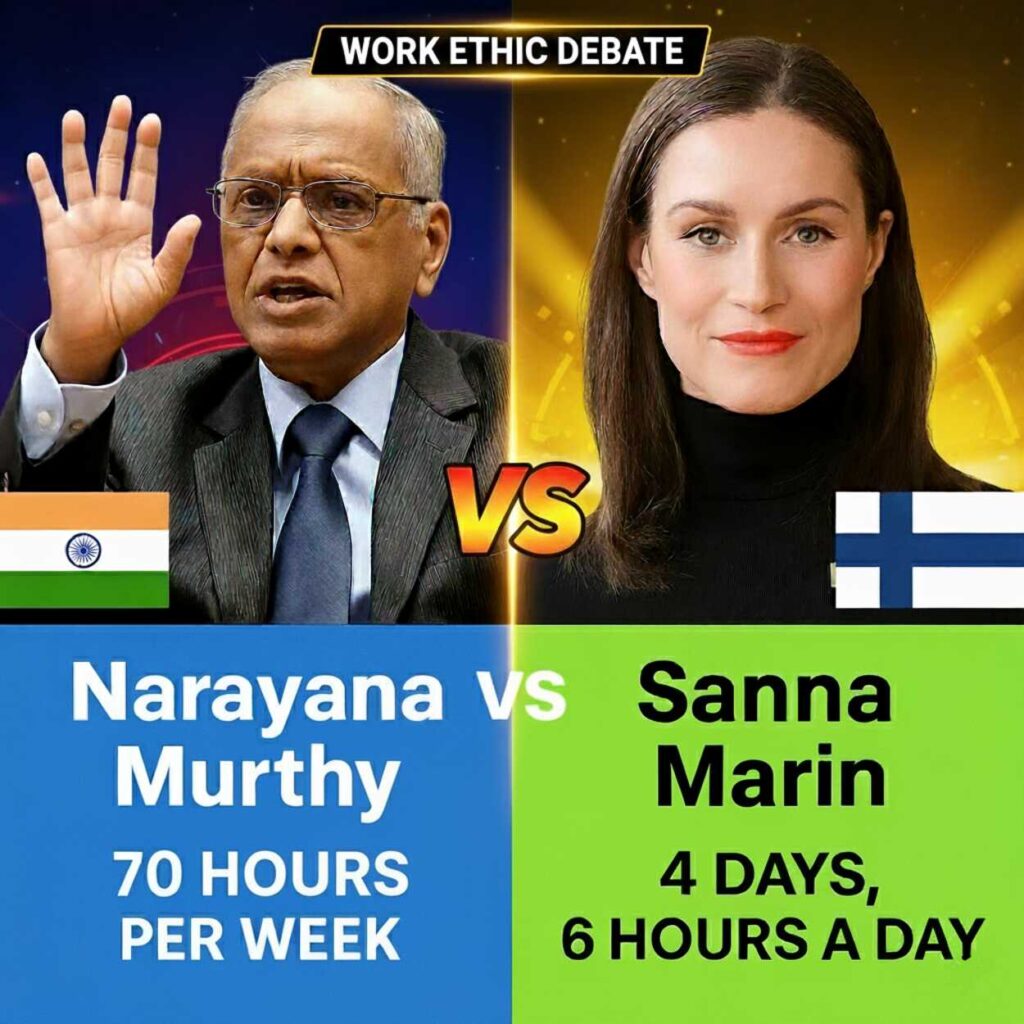Table of Contents
Introduction : Sanna Marin vs Narayana Murthy- Work Revolution
In recent years, public debates about work hours, productivity, and work-life balance have intensified. Two striking and opposing visions have captured global attention:
- In Finland, Sanna Marin once proposed reducing work time through a four-day workweek and six-hour workdays.
- In India, N. R. Narayana Murthy, co-founder of Infosys, has argued that young Indians should be ready to work 70 hours per week to compete globally.
These ideas represent very different philosophies about labor, efficiency, and human well-being. This article explores both, considers their merits and critiques, and tries to draw lessons for our context.

The Sanna Marin Proposal: Four Days, Six Hours
Who is Sanna Marin?
Sanna Marin is a Finnish politician who served as Prime Minister of Finland from December 2019 until June 2023. She was known for being one of the world’s youngest national leaders and led a coalition government. Wikipedia Before becoming Prime Minister, Marin held the post of Minister of Transport, and she has long expressed interest in more flexible labor policies.
What Did She Propose?
At a party event (the Social Democratic Party’s 120th anniversary gathering) in August 2019, when Marin was still serving as Minister of Transport, she floated the idea of a four-day workweek and six-hour workdays. Her comment was phrased in aspirational, future-oriented terms: she asked, “Why couldn’t it be the next step? Is eight hours really the ultimate truth?” . She added that she believed people deserve “more time with their families, loved ones, hobbies … culture.”
However, it is important to note: her proposal was never a formal government policy at the time. The Finnish government later clarified that the idea was a vision and part of her party’s discussions, but not something currently on the legislative agenda. The government even issued public statements saying the four-day week is not part of the government’s program. Yle.fi
Why She Brought It Up
Marin’s idea resonated because it tapped into several currents:
- Work-life balance: She argued that people deserve time for family, culture, and rest.
- Efficiency and productivity: Some experiments elsewhere (like Sweden) suggested that reducing hours might push organizations to eliminate wasted time and improve focus.
- Social fairness and well-being: Her political base includes parties that emphasize social policies, well-being, and sustainable development.
While the idea generated excitement in media and public discourse, skeptics raised questions about feasibility, cost, and compatibility with global competition.
Challenges, Criticisms, and Reality Check
Because many media outlets ran headlines like “Finland to introduce a four-day workweek,” confusion arose. In truth:
- The Finnish government later clarified that there is no plan to implement four-day workweeks in Finland currently.
- Many reports misinterpreted her remarks, combining them into “shorter workweek become national policy.”
- Critics say that reducing hours could raise costs for employers (if wages must stay the same) or reduce output.
- Some argue that only certain sectors (white-collar, office jobs) can adapt; in manufacturing, services, healthcare, etc., full coverage is harder.
In practice, while Finland has explored models and smaller trials, the four-day / six-hour scheme remains mostly a vision, not a reality. Reuters
Lessons from Worldwide Experiments
Marin’s idea did not emerge in isolation. Various pilots across the globe provide insights:
- Sweden: Some care homes experimented with six-hour days, reporting improved staff satisfaction and health outcomes.
- Japan (Microsoft Japan): A trial of a shorter workweek increased productivity by about 40%.
- Other firms: Companies in the UK, New Zealand, and Ireland have tested four-day weeks with mixed but interesting results, especially in reducing absenteeism and improving morale. The Guardian
The general finding: shorter hours work best when combined with strong management, clear goals, elimination of waste, and trust. Simply reducing hours without rethinking processes can backfire.

Narayana Murthy’s View: Longer Hours to Compete
Who is N. R. Narayana Murthy?
N. R. Narayana Murthy is an Indian software engineer, entrepreneur, and co-founder of Infosys, one of India’s largest IT services firms. Over decades, he has played a key role in shaping India’s IT industry and is a respected voice in business and governance.
What Did He Say: 70 Hours per Week?
In October 2023, in a podcast and public statements, Murthy suggested that young Indians should adopt a mindset of working 70 hours a week in order to raise productivity and compete with fast-growing economies like Germany and China. He pointed out that India’s productivity is among the lowest globally and argued that long hours, combined with dedication, could help bridge that gap.
He explicitly cited historical examples of Germany and Japan putting in hard hours to rebuild after war. His phrasing was strong: “my request is that our youngsters must say ‘this is my country. I’d like to work 70 hours a week.’” www.ndtv.com
Reaction, Critique, and Clarification
Murthy’s remarks ignited a firestorm of reactions:
- Many critics said his idea risked promoting exploitation, especially for junior employees and those earning modest wages.
- Others argued that quality matters more than quantity—that working smart is superior to working long.
- Some pointed out that many Indian workers already suffer from overwork, stress, burnout, and poor mental health.
In January 2025, Murthy offered a clarification: he insisted his suggestion was not a mandate and that no one can force others to put in such hours. He said that in his own career, he often worked from early morning until late evening for 40 years—but that was a personal choice, not a directive for others. He urged people to reflect (introspect) and choose their own path.
Still, the dust from the debate has not settled.
Defense, Neuroscience View, and Pushback
Some have tried to defend Murthy’s proposition by framing it not just as hard work but as passion, discipline, and alignment with national goals. After all, his reputation and career lend weight to his voice.
A neurologist, Dr. Sid Warrier, weighed in by suggesting the brain’s reaction to work depends on whether someone identifies with their work: if it feels like “flow” or purpose, long hours may feel less stressful; but for many, long hours without passion become burnout. The Economic Times
Others said that even in the “flow state,” overdoing it is harmful. Also, they argued that leaders must be careful when encouraging longer hours because junior workers have fewer privileges (rest, breaks, autonomy) than top executives.
Contrasting the Two Visions of Sanna Marin vs Narayana Murthy
We now have two contrasting proposals:
- Sanna Marin (Finland): Reduce working time (4 days, 6 hours) to raise well-being and efficiency.
- N. R. Narayana Murthy (India): Adopt long hours (70 hours/week) to boost productivity and compete globally.
Let’s compare them across multiple dimensions.
| Dimension | Sanna Marin’s shorter-hours vision | Murthy’s longer-hours vision |
|---|---|---|
| Philosophy | Belief in rest, balance, efficiency, human dignity | Belief in sacrifice, dedication, national ambition |
| Assumed baseline | Work is often inefficient, and extra hours don’t always yield more output | More hours = more output, or potential output |
| Risk to employees | If done poorly, could reduce wages or overload essential sectors | Burnout, mental/physical strain, overexploitation |
| Who benefits | Workers (more free time), even employers (through focus) | Nation and ambitious workers, but risk inequality |
| Feasibility | Harder in sectors like manufacturing, services, infrastructure | Easier to propose, but hard to sustain across all levels |
| Motivational appeal | For those seeking balance and sustainable life | For high achievers, ambitious youth |
| Scaling globally | Requires rethinking processes, trust, technology | Requires oversight to avoid abuse |
In short: Marin’s model leans toward human-centered productivity, whereas Murthy’s leans toward ambition-driven productivity.

Sanna Marin vs Narayana Murthy : Which One Makes Sense – and When?
It’s not a simple “one is right, the other is wrong.” The answer depends on context, sector, and implementation.
Situations Favoring Shorter Hours
- Knowledge/office work where focus, creativity, and mental energy matter more than sheer hours.
- Environments where overwork is already causing burnout, attrition, health issues.
- Nations or companies far enough in development to absorb short-term costs for long-term gains in well-being.
- Jobs with flexibility and autonomy.
Situations Favoring Longer Hours (or Intense Sprints)
- Startups or early growth phases where urgency is high.
- Tasks with deadlines or crisis response.
- Highly motivated or mission-driven teams, functioning more like creators than employees.
- Cultures where long hours are already normalized—but with safeguards.
Even then, long hours must come with proper compensation, rest intervals, social protections, and clear limits to prevent abuse.
What About India and the Infosys Context?
Because Murthy’s suggestion came from an Indian business leader, the Indian context makes this discussion more concrete.
Infosys, Murthy, and the Internal Contradiction
Interestingly, even though Narayana Murthy has pushed for 70-hour weeks in public statements, Infosys as a firm has taken a more moderate message recently. The company issued advisories warning staff against frequent overtime and urging better work-life balance.
Infosys HR also implemented systems to monitor remote work hours and send alerts if employees exceed a threshold (e.g. 9 hours 15 minutes per day). This suggests that while Murthy’s ideal is radical, in operational terms, Infosys is more cautious.
This gap between founder’s vision and company practice is not uncommon: leaders often inspire, but organizations must also manage risk, compliance, and employee welfare.
Potential Roadblocks in India
India’s labor environment presents additional challenges:
- Infrastructure, commuting, and power outages already eat into productivity.
- Many workers lack social safety nets or health protections.
- The gap between senior leadership and junior employees is stark.
- Work culture in many Indian companies is already long hours, and pushing further without systemic change could push it into toxic overwork.
Murthy’s call may inspire ambition and urgency, but if implemented without safeguards, it risks deepening inequality and health costs.
Reflections and Balanced View
In practice, perhaps the best path lies somewhere in between. Neither extreme is fully viable universally.
- For many sectors, we could reduce unproductive hours (meetings, redundant tasks, micromanagement) before pressing for more hours.
- Hybrid models: occasional “sprints” where longer hours are expected, balanced with periods of lighter load.
- Legal protections: overtime caps, mandatory rest breaks, fair compensation.
- Focus on output, not input. The goal should be effective, not just more hours.
- Cultural change: organizations need to trust employees, empower them, and mitigate burnout.
The main keyword to derive from both sides: purposeful work. Whether you work six hours or seventy, what matters is direction, meaning, focus, and fairness.
Sanna Marin vs Narayana Murthy: Conclusion
The debate between Sanna Marin’s proposition for a four-day workweek / six-hour days and N. R. Narayana Murthy’s call for 70-hour workweeks is a clash of ideals: balance and well-being versus drive and ambition. Each has logic, risks, and appeal.
- Marin’s vision offers hope for a humane model of productivity that respects human limits.
- Murthy’s vision appeals to urgency and competitiveness in a global economy.
But in real life, context matters. Efficient operations, fair policies, and human dignity should guide any path. For India, in particular, Murthy’s call cannot be adopted wholesale without safeguards, especially for junior workers. The Infosys example shows that even when leaders advocate high hours, the organization must balance that with employee welfare.
Disclaimer: This article is based on publicly available information and credible sources. All views, statements, and interpretations are presented for informational and educational purposes only. The publication does not intend to misrepresent any individual or organization. Readers are advised to verify facts independently before drawing conclusions.

